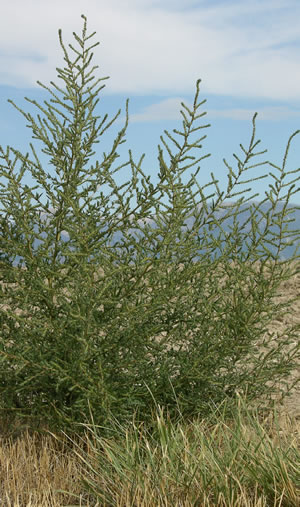Management of Glyphosate (RoundUp and generic products) Resistant Kochia with Soil Applied Herbicides
Ed Davis, Research Associate; Tim Seipel, Research Scientist; Fabian Menalled, Crop Weed Specialist
Kochia (Kochia scoparia (L.) Schard.) is an early germinating summer annual broadleaf weed commonly found in Montana’s crops, pastures, and roadsides. It is a self- and cross- pollinated species with pollen moving between plants on the wind. Each kochia plant can produce over 10,000 seeds. Kochia has a unique seed dispersal mechanism; after a plant has matured, as a tumble-weed, it breaks of at the ground and rolls in the direction of a slope or wind. These traits could result in a rapid spread of plants. Another problem that further complicates kochia management is the selection of herbicide-resistant biotypes.
|
Site Location |
Soil Texture |
Organic Matter (%) |
pH |
|---|---|---|---|
|
Bozeman |
Clay Loam |
2.3 |
7.1 |
|
Denton |
Sandy Clay Loam |
3.2 |
7.7 |
|
Gilford |
Loam |
4.2 |
7.8 |
|
Havre |
Loam |
1.8 |
7.9 |
|
Miles City |
Loam |
2.2 |
8.2 |
|
Townsend |
Loam |
2.1 |
7.9 |
Table 1. Site locations and soil characteristics at each site where herbicide trials were conducted.
|
Herbicide |
Herbicide Group |
Rate of Application (oz/acre) |
|---|---|---|
|
Fall Applied |
||
|
Metribuzin + Spartan |
5 & 14 |
8 + 4 |
|
Spartan Charge |
14 |
7.62 |
|
Valor |
14 |
4 |
|
Spring applied |
||
|
Authority MTZ |
5 & 14 |
12 |
|
Spartan Charge + Metribuzin |
14 & 5 |
6.34+8 |
|
Spartan Charge |
14 |
6.34 |
|
Valor |
14 |
3 |
Table 2. List of soil applied herbicides with potential for controlling kochia in either fall or spring. At the six tested sites, all these products or product combinations controlled over 90% of kochia.
Herbicide resistance results from repeated use of the same herbicide and is the innate ability of a weed biotype to survive and reproduce after treatment with an herbicide dose that would normally be lethal. In Montana, the first herbicide-resistant biotypes of kochia were found in 1984 when individuals were not controlled with Group 5 Photosystem II inhibitor herbicides such as atrazine. In croplands, kochia resistance to Group 2 ALS inhibitors herbicides including chlorsulfuron (Glean, Telar) and metsulfuron-methyl (Escort) was detected in 1989. In 1995, kochia resistance to Group 4 Synthetic Auxins herbicides including dicamba (Banvel) and furoxypyr (Starane) was confirmed. The first kochia biotypes resistant to Group 9 EPSP synthase inhibitors such as glyphosate (RoundUp and other generic products) were confirmed in Montana in 2012. More recently, multiple resistance in kochia to both Group 2 ALS inhibitors herbicides and glyphosate were found.
Herbicide resistance results from repeated use of the same herbicide and is the innate ability of a weed biotype to survive and reproduce after treatment with an herbicide dose that would normally be lethal. In Montana, the first herbicide-resistant biotypes of kochia were found in 1984 when individuals were not controlled with Group 5 Photosystem II inhibitor herbicides such as atrazine. In croplands, kochia resistance to Group 2 ALS inhibitors herbicides including chlorsulfuron (Glean, Telar) and metsulfuron-methyl (Escort) was detected in 1989. In 1995, kochia resistance to Group 4 Synthetic Auxins herbicides including dicamba (Banvel) and furoxypyr (Starane) was confirmed. The first kochia biotypes resistant to Group 9 EPSP synthase inhibitors such as glyphosate (RoundUp and other generic products) were confirmed in Montana in 2012. More recently, multiple resistance in kochia to both Group 2 ALS inhibitors herbicides and glyphosate were found.
Controlling glyphosate resistant kochia in non-crop fallow periods with soil residual herbicides provides an opportunity to rotate herbicide site of actions, reducing the pressure towards the selection of herbicide-resistant biotypes. To ensure that soil active herbicides are in place prior to kochia emergence, they have to be applied in the fall as a post-harvest treatment, or early spring, prior to kochia emergence. The goal of these applications is to keep the fallow area free of kochia from April through mid- July as its germination and establishment is unlikely after mid-July.
Between 2013 and 2015 with support from the Montana Wheat and Barley Committee, we assessed the potential of soil-applied herbicides to control glyphosate resistant kochia. To encompass a wide range of environmental conditions, we selected six sites across Montana (Table 1) and tested 17 different herbicide combinations that were applied in late fall 2013 or early spring 2014. We then seeded either spring wheat or winter wheat to assess crop safety.

Although we observed site to site differences in herbicide performance, of the 17 different herbicides screened, three herbicides or herbicide mixtures (Metribuzin + Spartan, Spartan Charge, and Valor) controlled over 90% of kochia (Table 2) in fall applied post- harvest applications. Four herbicide or herbicide mixtures (Authority MTZ, Spartan Charge + Metribuzin, Spartan Charge, and Valor) controlled over 90% of kochia in spring applications, while causing no damage and not reducing yield from residual effects (Table 2). The different herbicide mixtures had different herbicide groups (modes of action) when compared to those typically used during the crop phase. These herbicides give farmers more options in controlling kochia through the fallow phase and increase the diversity of herbicides currently used.
Reducing the risk of selecting for herbicide-resistant biotypes requires producers to routinely scout prior to and following each herbicide application. Producers should also rotate management practices. For example, crop rotation is an excellent tool to reduce the selective pressure on herbicide resistant weeds.
More information on herbicide resistance can be found in the MSU Extension MontGuide, Preventing and Managing Herbicide-resistant Weeds in Montana (460KB PDF).
Further Information
Originally published in the Fall 2016 issue of the Montana IPM Bulletin. For more information, contact Tim Seipel or Fabian Menalled.

